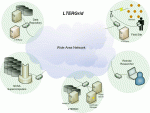Grid Pilot Study focuses on emerging technology
Landscape acoustic sensing has been a passion of Dr. Stuart Gage for the past five years. As a Distinguished Professor at Michigan State University and a principal investigator at the Kellogg Biological Station LTER, Gage is managing a network of sensors that capture and record a large amount of acoustic data from the environment every 30 minutes. His dream now is to seamlessly integrate this network of sensors into a single virtual system that collects, stores, and analyzes the data automatically. Recently, Gage participated in the LTER Grid Pilot Study, a demonstration of grid technology that has created a web-based environment for the analysis of his acoustic data.
The Grid Pilot Study is part of the LTER Network Information System (NIS) strategic planning effort to investigate grid middleware and high-performance computer applications. Grid middleware is the software that enables interoperability between heterogeneous computer systems, including those systems that provide services for the analysis of acoustic data. Gage observes, "The issue of scaling has emerged as a significant issue, and grid technologies are an important approach to solving large scale data and analytical requirements."
The Pilot Study was supported by the National Center for Supercomputer Applications (NCSA), a partner in the National Science Foundation GRIDS Center, and the LTER Network Office (LNO). The study began in March 2005 and successfully demonstrated a functional application called the "Biophony Grid Portal" to the LTER Coordinating Committee’s September 2005 meeting in Cape Charles, Virginia.
Researchers access the Biophony Grid Portal via a secure, one-time log-on process that verifies their user names and passwords with the LTER LDAP registry. Once logged on, a researcher can select an acoustic signature from a dataset of known sounds (e.g., chirping sparrow) and determine if the sound (and hence the species) is present in a selected time series of acoustics contained in a digital library. The application computes the probability of match between the signature and each unknown sound in the library, along with an option to generate a sonogram, sound profile, power spectrum, and frequency histogram of the acoustic samples in the selected time series.
From a cyberinfrastructure perspective, the Grid Pilot Study utilized standard middleware components of the Globus Toolkit and other grid software to achieve secure authentication and transactions, enabling remote job submission, file transfer, and data analysis. All transactions in the system were logged into a relational database for use in audit and data provenance reporting. The use of standard middleware components ensures interoperability between the LTER NIS and resources from other networks, such as the Science Environment for Ecological Knowledge’s "EcoGrid" or the National Ecological Observatory Network (NEON).
The success of the Grid Pilot Study, exemplified by the Biophony Grid Portal application, fully demonstrated the efficacy of grid middleware in supporting LTER science, and identified middleware components that could meet the requirements of a production version of an LTER Grid. Such insight would have been difficult to grasp without a hands-on evaluation of the technology. The pilot study provided a vision for a grid computing infrastructure (Figure 1) as an important component of the LTER NIS.
For more information, read DataBits, the Information Managers' newsletter, online at www.lternet.edu/databits

 Enlarge this image
Enlarge this image